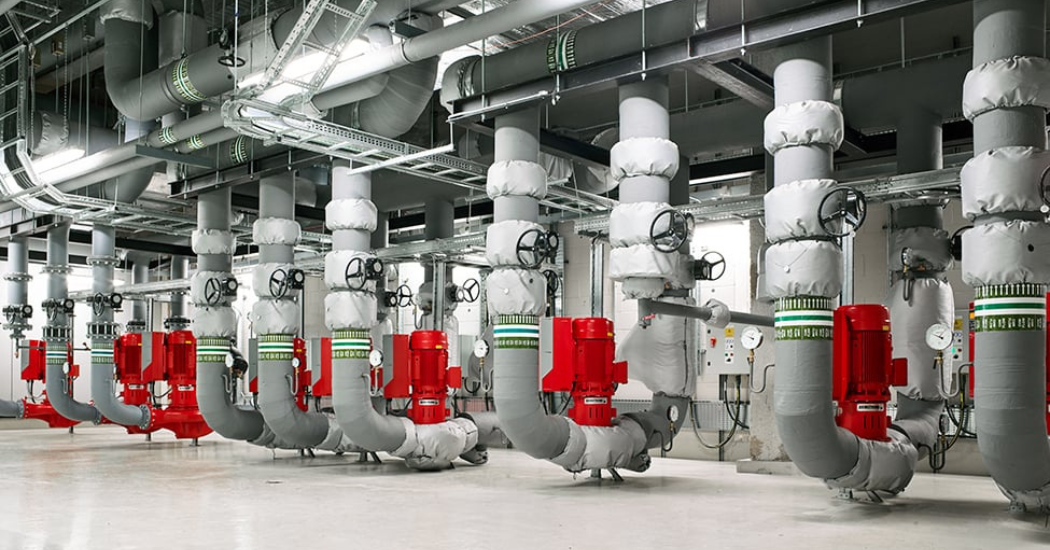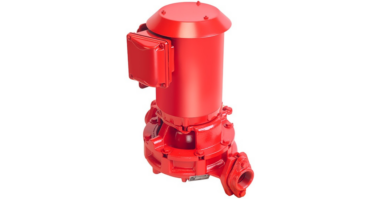Pump categorization can be based on displacement method, fluid flow direction, orientation, and control capabilities. Major types of pumps include positive-displacement pumps, centrifugal pumps, and axial flow pumps.
Centrifugal versus axial
In centrifugal pumps, an impeller rotates within a volute or diffuser casing. The fluid enters along the centerline. With radial impellers, the direction of flow changes by ninety degrees as it flows through, is accelerated and exits at right angles to the shaft.
In axial flow pumps, the direction of flow is unchanged. Axial flow pumps tend to be used in high-flow, low-head applications such as pumping for flood drainage. Most pumps used in HVAC and fire safety systems are centrifugal pumps.
Single stage versus multistage
When a casing contains only one impeller, it is referred to as a single-stage pump. When a casing contains two or more impellers, it’s called a multi-stage pump.
Motor and shaft orientation
Pump designs can also be categorized according to the orientation of the motor and shaft. Vertical pumps mount the motor directly above the casing. This makes the pump installation more compact than a horizontal pump. Any out-of-balance forces are transmitted horizontally and damped out by the weight of the pie work system and the water contained within.
Horizontal pumps are floor-mounted requiring positioning on a concrete plinth, or a spring-loaded inertia base. Long-coupled horizontal pumps require careful adjustment so that the motor and the pump shafts are properly aligned.
End suction pumps draw water into the impeller horizontally and typically push water out vertically In-line pumps place the pump inlet and the pump outlet in a straight line, enabling fitting into the pipe work.
Single motor versus multiple motor
Traditional single pumps mount one rotating device (motor) in a single casing and use a single impeller.
Twin pumps mount two separate motors in a shared casing with single inlet and discharge connections
DualArm Pumps also mount two separate motors in a shared casing with single inlet and discharge connections with the added benefit of isolating valves enabling one pump to be serviced while the other remains in operation. The DualArm design adds a mechanical diverter or check valve that allows the two motors to share the workload. The two motors rotate in the same direction.
The Tango pump mounts two separate motors in a shared casing with single inlet inlet and discharge connections. This design adds a mechanical check valve that allows the two sides of the pump to share the workload but prevents reverse flow in the event of a failure of one of the rotating assemblies. The two motors rotate in opposite directions for added stability and reduced vibration.
Fixed speed versus variable speed
Fixed speed pumps operate at a set speed (RPM) and do not include an integrated variable speed controller or drive. The pump motor and fluid flow within larger systems is controlled through the modulation of control valves. Pumps are sized according to a duty where the system curve intersects the pump curve.
Variable speed pumps are controlled by a variable speed drive. Pump operating speeds can be static or dynamic, according to the needs of the larger system. Pumps are sized according to a range of performance points on a system curve and the performance curve of the pump motor. Pumps are sized to meet the expected maximum and minimum flows and heads required, with care taken to make sure that the pump size selected will be most efficient at the point where it’s going to operate most of the time.
For assistance with selecting the exact design of pump that will provide the most value for your installation or building, please contact your local Armstrong representative. You can also reach one of our HVAC experts via e-mail to info@Armstrongfluidtechnology.com




